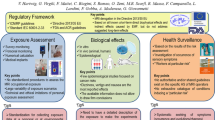Abstract
Purpose
The operation of implantable cardioverter defibrillators (ICD) can be disrupted by exposure to electromagnetic fields (EMF). In the workplace, some workers can be exposed to EMF higher than in daily life. We present an approach aimed at assessing fitness for work in this type of situation, based on in situ case studies in the absence of clinical and in vivo studies.
Methods
A risk assessment protocol was developed to measure the 50-Hz electric and magnetic fields in the various places where the worker is likely to be present. These measures are taken in the worker’s presence, while monitoring the ICD operation.
Results
All cases of implanted ICD workers in EDF, the French electricity company (around 130,000 employees), and potentially exposed to high electric and/or magnetic fields, between 2004 and 2009 are presented. These three cases involved different work circumstances, with exposure to 50-Hz electric and/or magnetic fields. No interference of the ICD was observed.
Conclusions
This information provides the basis for the occupational physician to make a decision about fitness for work. This procedure can be extended to other medical implants and to electromagnetic fields frequencies other than 50-Hz.


Similar content being viewed by others
Notes
A safety mode designed in case of pacemaker inhibition, due for example to interference.
References
Beerlage MAM, Lagendijk CLW (2009) EMF at natural gas production sites in the Netherlands: case study for an employee with a pacemaker. International Colloquium Power Frequency Electromagnetic Fields ELF EMF, Sarajevo, Bosnia and Herzegovina, 3–4 June 2009
Butrous GS, Male JC, Webber RS, Barton DG, Meldrum SJ, Bonnell JA, Camm AJ (1983) The effect of power frequency high intensity electric fields on implanted cardiac pacemakers. Pacing Clin Electrophysiol 6:1282–1292
CENELEC (2010) Procedure for the assessment of the exposure to electromagnetic fields of workers bearing active implantable medical devices. General. CENELEC. EN 50527-1, p 44
Dawson T, Caputa K, Stuchly M, Shepard R, Kavet R, Sastre A (2002) Pacemaker interference by magnetic fields at power line frequencies. IEEE Trans Biomed Eng 49:254–262
European Community Council (2004) Directive 2004/40/EC of the European Parliament and of the Council of 29 April 2004 on the minimum health and safety requirements regarding the exposure of workers to the risks arising from physical agents (electromagnetic fields) (18th individual Directive within the meaning of Article 16(1) of Directive 89/391/EEC). Official J Eur Union L 159:1–26
Gimbel JR, Cox JJ (2007) Electronic article surveillance systems and interactions with implantable cardiac devices: risk of adverse interactions in public and commercial spaces. Mayo Clin Proc 82:318–322
Gwechenberger M, Rauscha F, Stix G, Schmid G, Strametz-Juranek J (2006) Interference of programmed electromagnetic stimulation with pacemakers and automatic implantable cardioverter defibrillators. Bioelectromagnetics 27:365–377
Irnich W (2002) Electronic security systems and active implantable medical devices. Pacing Clin Electrophysiol 25:1235–1258
Joosten S, Pammler K, Silny J (2009) The influence of anatomical and physiological parameters on the interference voltage at the input of unipolar cardiac pacemaker in low frequency electric fileds. Phys Med Biol 54:591–609
Katrib J, Nadi M, Magne I, Schmitt P, Kourtiche D (2009) In vitro approach of cardiac defibrillators immunity in low frequency electromagnetic environment. BioEM 2009, Davos (Switzerland), 15–19 June 2009
Katrib J, Nadi M, Schmitt P, Roth P, Magne I, Audran F, Kourtiche D (2010) Risk assessment of ICDs in magnetic fields up to 4 mT at power line frequency. Physiological Measurement, submitted
Magne I, Souques M, Héro M (2007) Quelle conduite tenir après l’implantation d’un défibrillateur cardiaque chez un travailleur exposé aux champs magnétiques? Radioprotection 42:211–218
Magne I, Audran F, Mayaudon E, Clément D, Deschamps F (2009) 50 Hz electric and magnetic field measurements in high voltage substations. Internationa Colloquium Power Frequency Electromagnetic Fields ELF EMF, Sarajevo, Bosnia and Herzegovina, 3–4 June 2009
Marchal C, Nadi M, Tosser A, Roussey C, Gaulard M (1989) Dielectric properties of gelatine phantoms used for simulations of biological tissues between 10 and 50 MHz. Int J Hyperthermia 5:725–732
Mathew P, Lewis C, Neglia J, Krol RB, Saksena S (1997) Interaction between electronic article surveillance systems and implantable defibrillators: insights from a fourth generation ICD. Pacing Clin Electrophysiol 20:2857–2859
Nadi M (2008) Etude expérimentale in vitro de l’immunité des défibrillateurs cardiaques en environnement électromagnétique basse fréquence. Journée Scientifique de la SFRP, La Tronche (France) 7 octobre 2008
Schmitt P, Joly L, Roth P, Magne I, Nadi M (2005) Implantable defibrillators immunity to low frequency electromagnetic disturbances. Bioelectromagnetics 2005, Dublin (Ireland), 19–24 June 2005
Scholten A, Silny J (2001) The interference threshold of cardiac pacemakers in electric 50 Hz fields. J Med Eng Technol 25:1–11
Silny J (2003) The interference of electronic implants in low frequency electromagnetic fields. Arch Mal Coeur Vaiss 96 Spec No 3:30–34
Souques M, Trigano J, Frank R, Magne I, Blandeau O, Gernez J (2007) Fonctionnement des stimulateurs cardiaques en présence d’un champ magnétique 50 Hz dans la limite de la Recommandation européenne. Environnement, Risques et Santé 6:111–118
Toivoinen L, Valjus J, Hongisto M, Metso R (1991) The influence of elevated 50 Hz electric and magnetic fields on implanted cardiac pacemakers: the role of the lead configuration and programming of the sensitivity. Pacing Clin Electrophysiol 14:2114–2122
Trigano A, Blandeau O, Souques M (2005) Clinical study of interference with cardiac pacemakers by a magnetic field at power line frequencies. J Am Coll Cardiol 45:896–900
Acknowledgments
The authors thank all the participants involved in these different workplace studies, especially the occupational physicians who organized the onsite measurements.
Conflict of interest
The authors declare that they have no conflict of interest.
Author information
Authors and Affiliations
Corresponding author
Rights and permissions
About this article
Cite this article
Souques, M., Magne, I. & Lambrozo, J. Implantable cardioverter defibrillator and 50-Hz electric and magnetic fields exposure in the workplace. Int Arch Occup Environ Health 84, 1–6 (2011). https://doi.org/10.1007/s00420-010-0599-y
Received:
Accepted:
Published:
Issue Date:
DOI: https://doi.org/10.1007/s00420-010-0599-y




